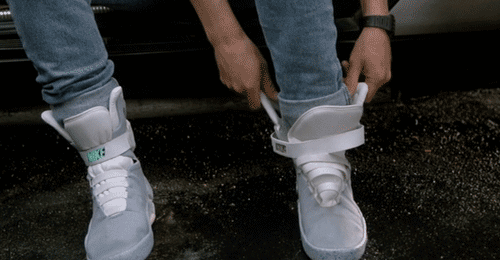“Why I Rock” is an ongoing series about why certain people rock (or rocked) certain things.
WHY I ROCK #1
SAMUEL HYLAND
One of the most conspicuous intersections between the worlds of film and fashion comes around the midway point of Forrest Gump. It seems as if things are finally looking up for its endearing protagonist – the dream girl has been attained, the fortune-500 list has been made; one can only assume that millions are to follow a key investment into “some fruit company (Apple).” Jenny Curran gifts him an early version of the classic Nike Cortez running shoe before things start going downhill.
I only wanted to get my hands on a pair of Nike Cortez’s after I saw Forrest Gump. In his arms they appeared hyper-patriotic, emblematic of a cult-of-personality soon to be attributed to the dynamic swoosh and its JUST DO IT counterpart. One of the many things interesting about the entire situation is that it came in the context of an uphill battle against Reebok, which, to my surprise a while back, was commanding Nike in sales up to when this hit the silver screen. Post-release, Nike skyrocketed to a 51% worldwide market share while Reebok plummeted down to about a fifth of that.
The point in question is that of a necessary conversation regarding promotion on the big-screen versus promotion via paid advertisement(s). Which is superior? In a sense, had a viewer seen promotion of the Cortez sneaker in a Nike-sponsored television commercial, there would have to have been a sort of skeptic wall preventing any purchase; Nike is legit telling you to buy Nike products. It’s like Donald Trump casually suggesting that you vote red in November – you know – as a concerned citizen.
But film, on the other hand, provides an unspoken loophole to the skeptic’s dynamic. Upon entering a screening, an audience member must assume that whatever he/she intends to watch is being presented with an allegiance to the plot and the plot only. Therein, the trust lies. Thus begins the contract: we’ll give you entertainment, you’ll give us control of your emotions. Once those heartstrings are tugged upon, everything becomes real. The mere appearance of a product can easily become an endorsement.
“Once those heartstrings are tugged upon, everything becomes real. The mere appearance of a product can easily become an endorsement.”
Such is the why to Nike’s timeless omnipresence: the ability to capitalize on youth-led movements; to ride the cultural wave. Though often given a lot less credit than deserved, the societal weight attributed to cinema in the late 20th Century is where a great deal of Nike’s longevity is owed. Back to the Future 2 saw Marty McFly (who already had a bit of relevance in his own right) rock a pair of self-lacing swooshes atop a hoverboard — and, with the amount of interest in the impossible that the film garnered, an image of Nike sneakers was consequently seared into the public mind alongside those of time travel, space flight, and other cool shit that hadn’t been thought of before. Nike had thrust itself into a conversation society was madly in love with. It didn’t drop the ball either. Student-athletes and sneakerheads alike will be among the first to tell you of the brand’s several reissues of Back to the Future high-tops; the 2007 version sported by Kobe Bryant at UNDFTD LA, the 2011 pair advertised by a peek inside Marty McFly’s closet, the 2016 issue capable of lacing itself up just like the movie, the much later 2016-2019 Nike Hyperadapt 1.0. Something to consider also: an original Back to the Future shoe (Nike MAG) was sold on Ebay for one-hundred million dollars back in 2018 – more than five times the budget of the actual movie.

I bought my first pair of Nike Cortez’s out of pocket in the seventh grade. Everything about the shoes made me feel as if I was beyond the scrawny pre-teen I existed as, from the fact that I had purchased them with my own cash, to the fact that I had seen something on the television, got to work, and manifested it onto my feet. They fitted bulkily onto my 12-year-old stompers, nothing so bad that I couldn’t play a game of pickup basketball. Yet, several times until they went missing a few weeks after I got them, I specifically remember asking out of gym class several times as to not scuff up my squeaky clean superpowers.
Unfortunately, like Forrest Gump, the arrival of my Cortez’s signalled an impending downfall of sorts. A moving sign appeared in my front lawn that November. A fat, blonde-haired, clipboard-carrying woman became a frequent visitor. People suddenly filtered in and out, very often while we were home, opening closets and cupboards, audibly talking about how my childhood bedroom would make a nice office space. And then we were out.
What I remember most about that time is that through my family losing its place, the feeling of superiority granted by my pair of Cortez’s never left my side. I still felt as if I was a superhero; and, to this day, I believe that it was because I knew I couldn’t afford to abandon it.
The verdict is that Nike sneakers (especially the Cortez) have transcended the ownership value of mere footwear. When someone rocks the swoosh, it’s about the idea. It’s the primary leg-up that Nike has on its competitors; concepts of the future, the present, the past, they are all constantly in conversation with each other. We’re not going by hoverboard, but we’re there for the ride.
To contribute to the “Why I Rock” series, send an email to [email protected].

